The AMD Radeon R9 Fury Review, Feat. Sapphire & ASUS
by Ryan Smith on July 10, 2015 9:00 AM ESTCompute
Shifting gears, we have our look at compute performance. As compute performance will be more significantly impacted by the reduction in CUs than most other tests, we’re expecting the performance hit for the R9 Fury relative to the R9 Fury X to be more significant here than under our gaming tests.
Starting us off for our look at compute is LuxMark3.0, the latest version of the official benchmark of LuxRender 2.0. LuxRender’s GPU-accelerated rendering mode is an OpenCL based ray tracer that forms a part of the larger LuxRender suite. Ray tracing has become a stronghold for GPUs in recent years as ray tracing maps well to GPU pipelines, allowing artists to render scenes much more quickly than with CPUs alone.

For LuxMark with the R9 Fury X already holding the top spot, the R9 Fury cards easily take the next two spots. One interesting artifact of this is that the R9 Fury’s advantage over the GTX 980 is actually greater than the R9 Fury X’s over the GTX 980 Ti’s, both on an absolute and relative basis. This despite the fact that the R9 Fury is some 13% slower than its fully enabled sibling.
For our second set of compute benchmarks we have CompuBench 1.5, the successor to CLBenchmark. CompuBench offers a wide array of different practical compute workloads, and we’ve decided to focus on face detection, optical flow modeling, and particle simulations.
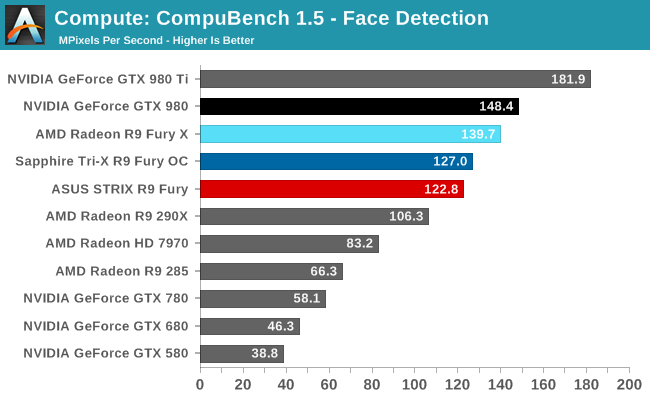
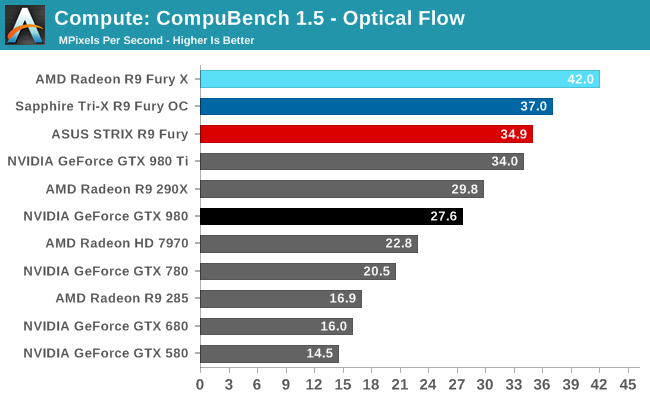

Not unlike LuxMark, tests where the R9 Fury X did well have the R9 Fury doing well too, particularly the optical flow sub-benchmark. The drop-off in that benchmark and face detection is about what we’d expect for losing 1/8th of Fiji’s CUs. On the other hand the particle simulation benchmark is hardly fazed beyond the clockspeed drop, indicating that the bottleneck lies elsewhere.
Our 3rd compute benchmark is Sony Vegas Pro 13, an OpenGL and OpenCL video editing and authoring package. Vegas can use GPUs in a few different ways, the primary uses being to accelerate the video effects and compositing process itself, and in the video encoding step. With video encoding being increasingly offloaded to dedicated DSPs these days we’re focusing on the editing and compositing process, rendering to a low CPU overhead format (XDCAM EX). This specific test comes from Sony, and measures how long it takes to render a video.
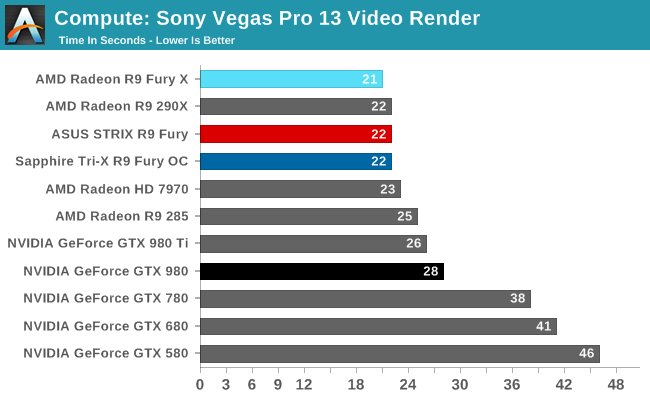
At this point Vegas is becoming increasingly CPU-bound and will be due for replacement. The R9 Fury comes in one second behind the chart-topping R9 Fury X, at 22 seconds.
Moving on, our 4th compute benchmark is FAHBench, the official Folding @ Home benchmark. Folding @ Home is the popular Stanford-backed research and distributed computing initiative that has work distributed to millions of volunteer computers over the internet, each of which is responsible for a tiny slice of a protein folding simulation. FAHBench can test both single precision and double precision floating point performance, with single precision being the most useful metric for most consumer cards due to their low double precision performance. Each precision has two modes, explicit and implicit, the difference being whether water atoms are included in the simulation, which adds quite a bit of work and overhead. This is another OpenCL test, utilizing the OpenCL path for FAHCore 17.
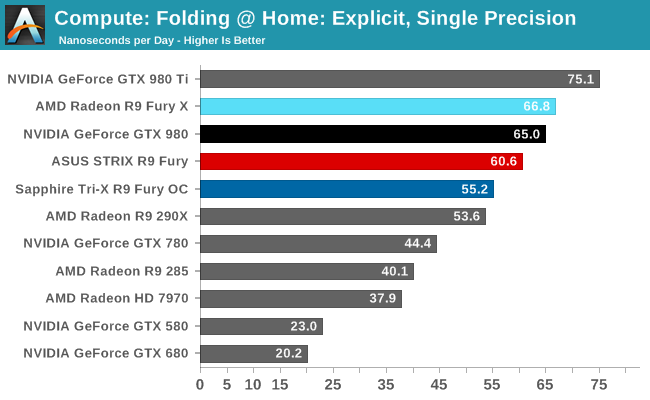
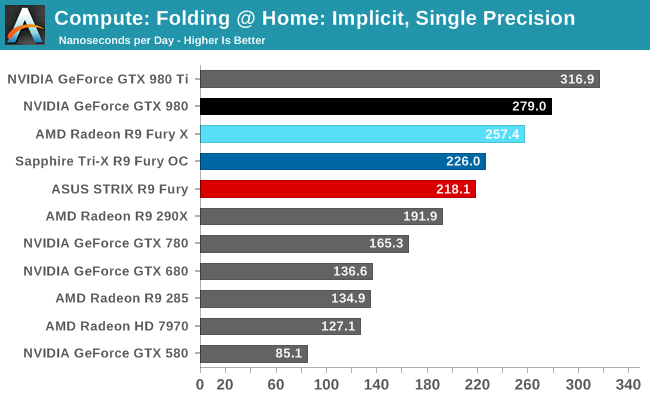

Overall while the R9 Fury doesn’t have to aim quite as high given its weaker GTX 980 competition, FAHBench still stresses the Radeon cards. Under single precision tests the GTX 980 pulls ahead, only surpassed under double precision thanks to NVIDIA’s weaker FP64 performance.
Wrapping things up, our final compute benchmark is an in-house project developed by our very own Dr. Ian Cutress. SystemCompute is our first C++ AMP benchmark, utilizing Microsoft’s simple C++ extensions to allow the easy use of GPU computing in C++ programs. SystemCompute in turn is a collection of benchmarks for several different fundamental compute algorithms, with the final score represented in points. DirectCompute is the compute backend for C++ AMP on Windows, so this forms our other DirectCompute test.
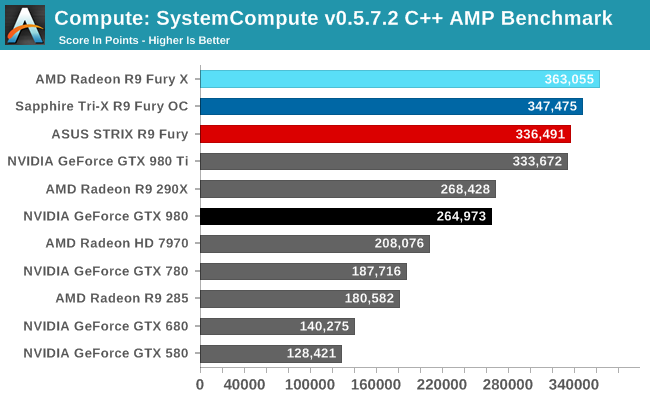
As with our other tests the R9 Fury loses some performance on our C++ AMP benchmark relative to the R9 Fury X, but only around 8%. As a result it’s competitive with the GTX 980 Ti here, blowing well past the GTX 980.










288 Comments
View All Comments
Asomething - Friday, July 10, 2015 - link
Amd knows this and already made some decent leaps from gcn1.1 to gcn1.2 but nvidia are still way ahead on geometry.FlushedBubblyJock - Wednesday, July 15, 2015 - link
Mr know it all sure read well..... didn't you, mr wise meister...Thank god you are here with your gigantic brain
QUOTE: " This indicates that at least for the purposes of the 3DMark test, the R9 Fury series is ROP bottlenecked "
YEP SURE AIN'T THOSE ROPs !
64 just like the FURY X, meaning the Fury X is MORE ROP BOTTLENECKED !
Thanks for playing amd fanboy... it's been so beneficial to have your ultimate knowledge and experience to reign in rumors and place the facts on the table.
tviceman - Friday, July 10, 2015 - link
Hey Ryan -Since you've loaded Fury X OC numbers in the the bench database, is there any chance you can load Fury OC, 980 TI OC, and 980 OC numbers as well? Overclocking cards, but choosing not to compare OC'd results against OC'd results of other cards makes it tedious to flip back and fourth. Basically I want to see your 980 OC'd results vs. Fury OC'd results and going all the way back to the 980 launch isn't ideal since there have been driver improvements and game performance improving patches as well.
deppman - Friday, July 10, 2015 - link
I agree. The common practice of showing factory OC'd cards against reference designs is misleading. Showing an EVGA factory clocked 980 versus a Sapphire factory clocked Fury is a more realistic comparison. A factory OC'd 980 probably matches or beats the Fury at the same price. But I can't determine that here because there is no comparison :(Ryan Smith - Friday, July 10, 2015 - link
The Fury OC results actually aren't supposed to be live. That's an error.The problem with putting OC results in Bench is that we don't keep them updated. So they would quickly grow stale and not be valid results.
darkfalz - Saturday, July 11, 2015 - link
The main problem with putting OC results in bench is YMMV. I've yet to get a card that's overclocked as well as the reviewed version (granted, you tend to find faults weeks or months after, whereas in a review they only need to be "stable" for that few days or a week during the review). Unigine Valley at Ultra / 4K DSR is a really good test for me.deppman - Sunday, July 12, 2015 - link
"The main problem with putting OC results in bench is YMMV"This is true if you personally overclock the card. However, the Sapphire is "factory clocked" higher and is guaranteed and warrantied at that clock - and it also performs better as a result. The EVGA GTX 980 Superclocked ACX 2.0 with a factory clock of 1266/1367MHz (about 10% above reference) is also guaranteed and warrantied at those clocks.
Including a card like this in the benchmarks would provide a real-world comparison to the Sapphire. At the very least it should at least be *mentioned* in the OC section or conclusions. Something like "Of course, the real elephants in the room are the GTX 980's from board partners like EVGA which are clocked 10% or more above reference. Maxwell has proven to scale very well with clock speed, and these should provide comparable or better performance than the Sapphire for nearly $100 less at current prices."
xenol - Friday, July 10, 2015 - link
I felt like AMD should've released this at $500 and put NVIDIA in a bit of a bind in that market sector.DigitalFreak - Friday, July 10, 2015 - link
AMD isn't in a position where they can afford to lose money on these cards.extide - Friday, July 10, 2015 - link
I HIGHLY doubt they would lose money at $500, however they definitely do want to get every last penny they can.